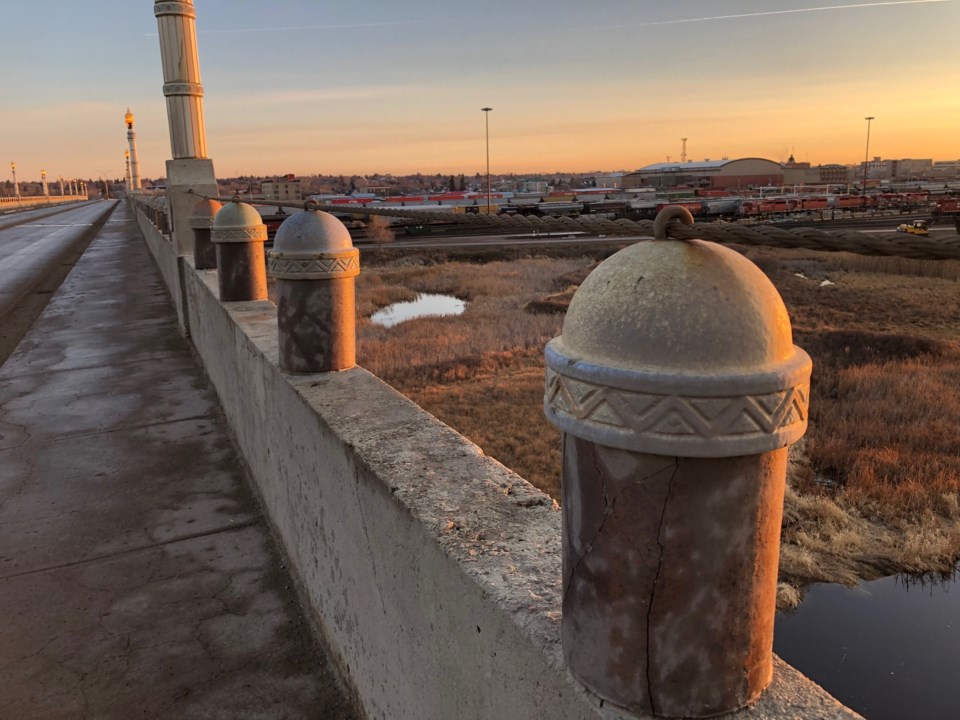MOOSE JAW — City administration is searching for ways to pay for the rehabilitation or reconstruction of the Thunderbird Viaduct, a structure with about 10 years left in its nearly 100-year-old bones.
Administration provided an update about the Fourth Avenue bridge during the Jan. 23 budget meeting, including the fact that the city is likely responsible for 85 per cent of project costs, based on a recent Canadian Transportation Agency (CTA) mediation decision.
The project design is 90-per-cent completed and tender- or shovel-ready, but because of how long mediation took, the two railway companies must re-approve the design, said Bevan Harlton, director of operations.
Furthermore, the city assessed the 1929-built Viaduct in 2020, which found that a full structure replacement is required in 15 years, otherwise, “the structure will not be fit to stand by 2035,” he continued.
The past two inspections showed the city should upgrade the bridge within five years, while the next inspection is this year and in 2028, the operations director said. Meanwhile, to strengthen the structure, the city installed a catcher beam in 2022, which has a lifespan of 20 years.
In 2023, city administration estimated that the bridge’s reconstruction cost was $22 million, but that has jumped to roughly $25.17 million, according to the budget report.
City administration has $4.86 million for this project that it’s bringing into 2025 from last year, while it expects to have $5.53 million next year, $5.97 million in 2027 and $5.97 million in 2028, with $3,244,476 expected from the rail companies.
Based on the CTA’s decision, Moose Jaw is responsible for roughly $21.9 million (85 per cent), while Canadian Pacific Kansas City is responsible for over $3 million (14 per cent) and Canadian National Railway is responsible for just over $200,000 (one per cent).
“As disappointing as this outcome is, it gives clarity to operations about what we’re looking at and what it will take to build or construct the bridge,” Harlton added.
When the work does commence, city hall will hang netting so nothing interrupts CN or CPKC activities, Harlton said. However, if the structure deteriorates before that happens, the city may conduct “more intrusive upgrades” that include working on the support piers.
If city hall converted the bridge to a pedestrian-only structure, the cost-savings would be minimal because it would still have to be safe to use, while if the bridge deck sunk, the structure would be lost, he continued.
“I think people are looking for the silver bullet here … (and) the way out or through this, and demolition isn’t it,” the director stated.
Harlton noted that it cost Saskatoon $41.2 million to demolish its 300-metre-long traffic bridge, while Winnipeg estimates that it will cost $17 million to $20 million to tear down its 600-metre-long Arlington Bridge.
In comparison, Thunderbird Viaduct is 420 metres long.
The operations director pointed out that if the three parties can’t reach a solution, it will likely cost nearly $50 million to demolish the structure in 15 years.
Meanwhile, the rebuilding would take 12 to 18 months and would create a 30-tonne structure — it’s currently 10 tonnes — with a 50- to 75-year lifespan
Harlton noted that the Ninth Avenue bridge could “shoulder the load” of extra traffic if the Fourth Avenue bridge were closed for construction. However, his department plans to perform repairs on the former in 2028 and 2029 because it requires work.
Harlton encouraged council to consider whether it was useful to continue investing in the bridge versus putting money into other structures or roads. He also encouraged them to think about the effect the bridge has on the community and what would happen — particularly to businesses — if it ceased to exist.
City manager Maryse Carmichael said the CTA decision helped administration realize where it stands with the project and realize it may need to analyze whether continued investment in the Viaduct is warranted. Conversely, it could be better to invest in other places, such as a bridge at 16th Avenue С����Ƶwest.
Carmichael added that 16th Avenue would only be viable if city hall spoke with CPKC to determine whether it would accept a new structure there.
“It’s disappointing that the funding didn’t come in different with the railroad, but I guess we shouldn’t be all that surprised,” said Coun. Heather Eby. “I think … it would be great to hear from the community and see how they’re really feeling.”
Eby didn’t think demolishing the Viaduct and constructing a bridge at 16th Avenue would “hit the budget book anytime soon,” while she pointed out that a new bridge would be unnecessary for the new С����Ƶ Hill school because those students wouldn’t need to cross it.




